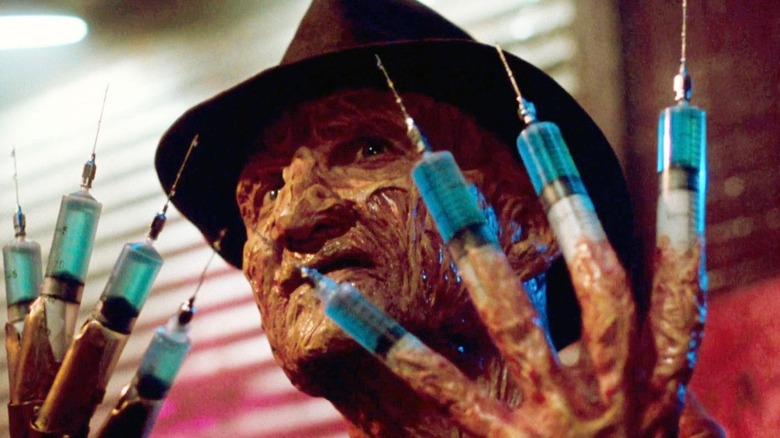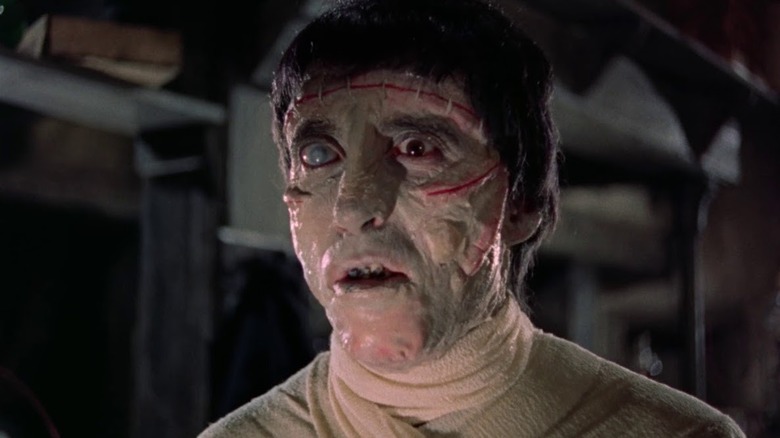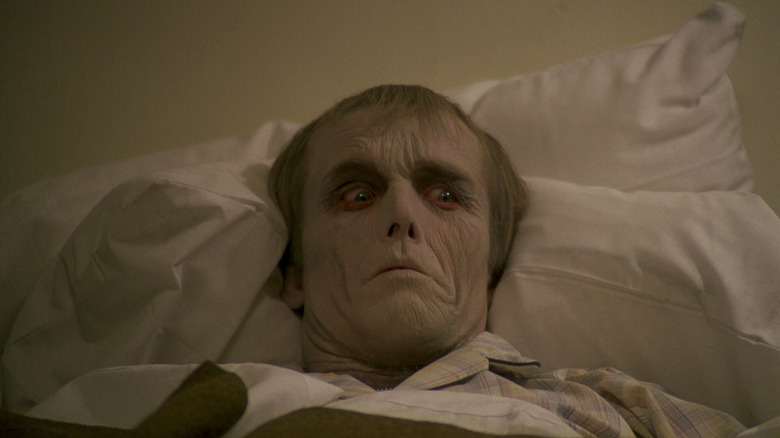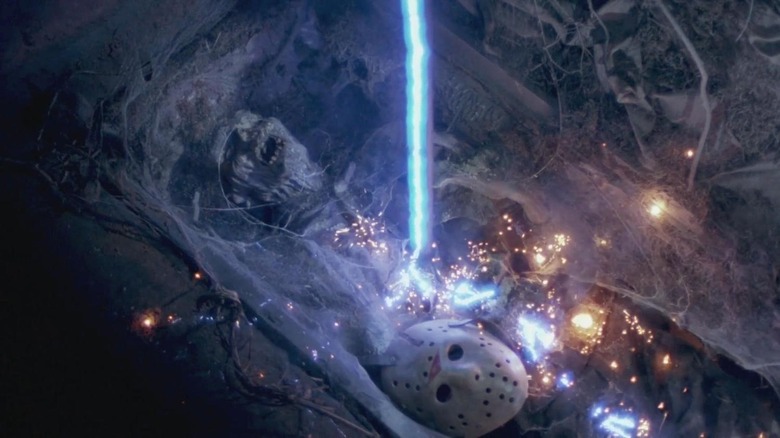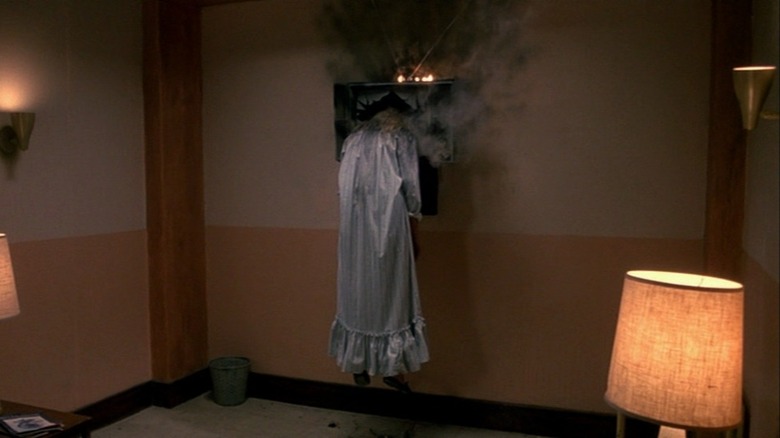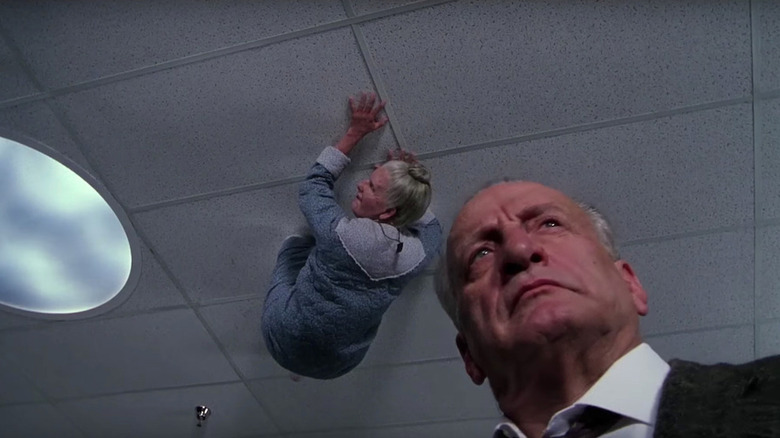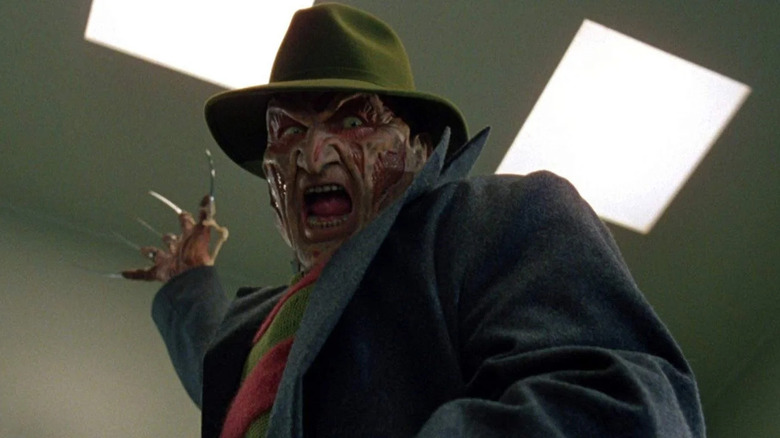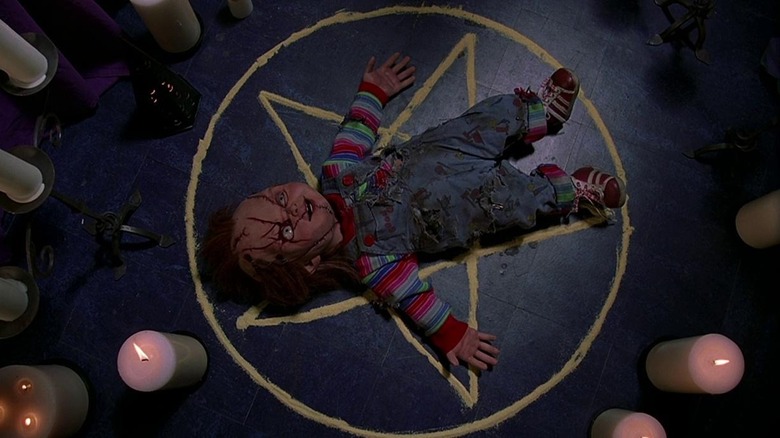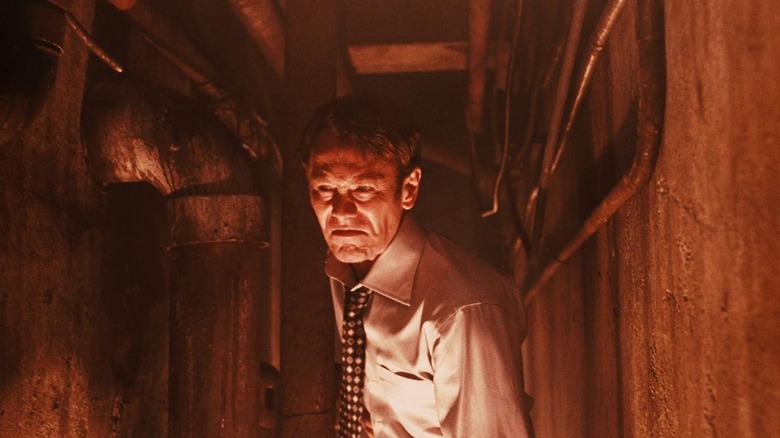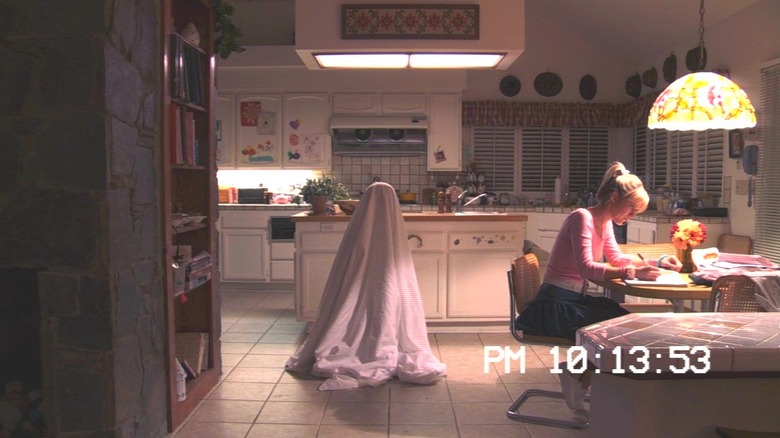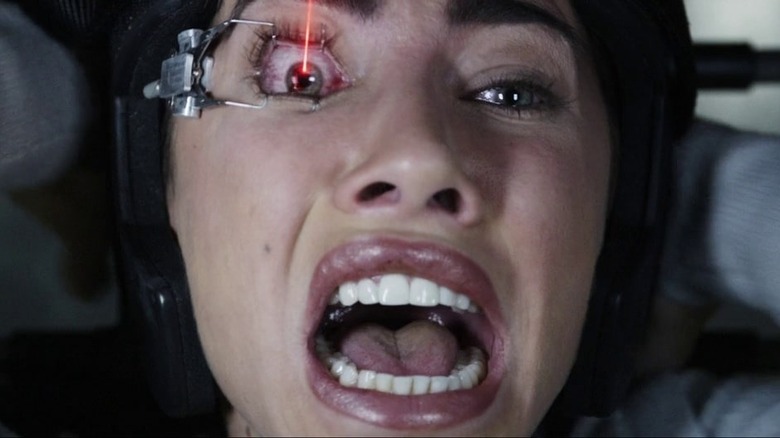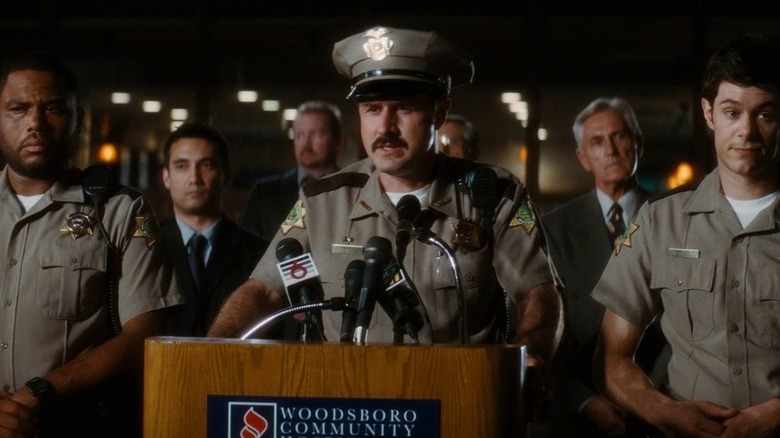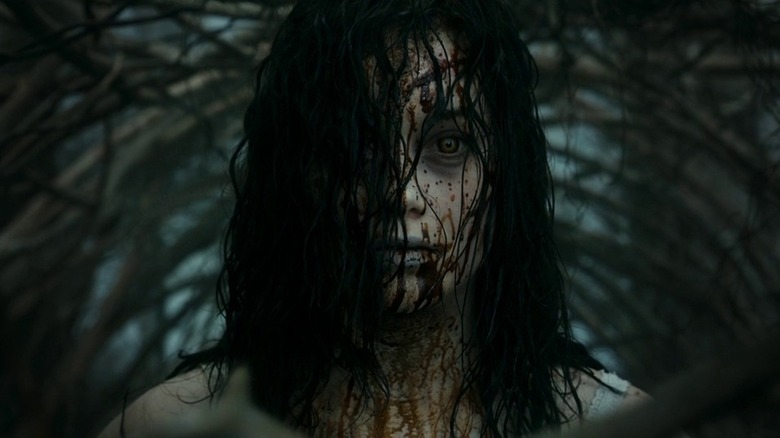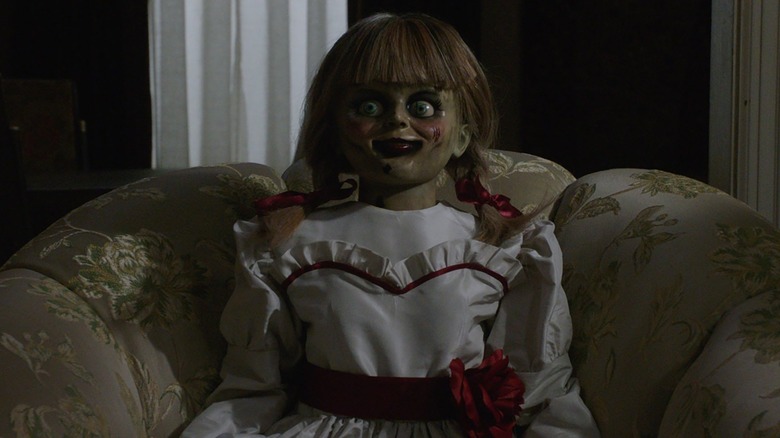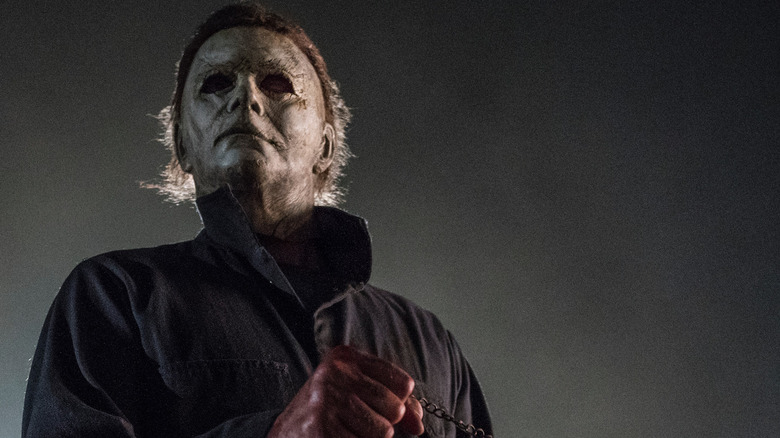Times Horror Movie Sequels Saved The Franchise
Much like zombies, ghouls, and most slasher villains, horror franchises have a remarkable inability to stay dead. But with certain illustrious series stretching back decades (looking at you, "Friday the 13th"), you're bound to eventually hit a breaking point where enough is enough for even the most die-hard fans. Luckily, cinematic defibrillators exist: films that prove the old girl's still got life in her yet, despite all evidence to the contrary.
"Saving" a horror franchise comes in a wide swath of shapes and sizes. Some films opt for a tonal heel turn, making once campy franchises deadly serious or adding a meta-twist to a series that has gotten seriously stale. Some franchises bounce back after their original creator returns to the helm, prodigal son-like, to steer a franchise back on its creative course. Others secure the future of their cinematic lineage through merely existing; setting inspired creative standards that define the series for decades to come.
So take a peek at the list below of films that, in one way or another, "saved" their horror franchise from a cinematic grave.
The Curse of Frankenstein
The true trendsetter for the horror output of Hammer Film Productions, 1957's "The Curse of Frankenstein" was, in many ways, the first official entry in what would become a long, illustrious string of glamorous, grisly genre efforts. Loosely adapting Mary Shelley's iconic novel, "The Curse of Frankenstein" was not Hammer's first horror effort, but was the one that really set the standard for "Hammer Horror" as a distinct brand of Gothic cinema. Directed by soon-to-be mainstay Terrence Fisher (who would go on to direct 1958's "Dracula" and 1959's "The Mummy," among other classics), "The Curse of Frankenstein" introduced Peter Cushing (then famous for his work on television) as a horror icon. Likewise, as the titular creature, Christopher Lee enjoyed his first of many Hammer outings.
A tremendous financial success, the film was, as Anglia Ruskin University professor Patricia MacCormack put it to the BBC, the "first really gory horror film, showing blood and guts in color." Setting the visual and tonal standard for the production house after its brief wartime flirtation with disaster (which included declaring bankruptcy in 1937), "The Curse of Frankenstein" would spawn six more Frankenstein films and a solid standard for the production house's ghoulish genre delights.
Dawn of the Dead
Ten whole years separate George A. Romero's 1968 classic "Night of the Living Dead" from its 1978 successor. The director, inspired by a chance visit to the Monroeville Mall, saw the grisly, commentary-riddled potential of a horror film set in a zombie-infested shopping center. However, unable to secure financing in the United States, it looked as though Romero's capitalism-critiquing follow-up was, uh, dead in the water. Mercifully for fans of the "Dead" franchise, Italian director Dario Argento was a huge fan of the original film. When he heard a sequel was in the works he was quick to help fund the movie and signed on to handle international distribution. (If you're familiar with the very difficult-to-keep-track-of "Zombi" series, this is where it all began).
Praised by critics as "one of the most compelling and entertaining zombie films ever," Romero's sequel, which sees four frantic survivors seeking refuge from the spreading epidemic in (you guessed it) a mall, ensured the continuation of the franchise. Four "of the Dead" films, all written by Romero, followed. The first sequel since the director's death in 2017, "Night of the Living Dead II" is set to premiere in 2022 with two more sequels in the works. There are also, and this cannot be overstated, a wild amount of series remakes and unauthorized sequels. The infectious power of a zombie contagion isn't to be underestimated, it seems.
Friday the 13th Part VI: Jason Lives
Okay, look, so the vast majority of the "Friday the 13th" films are "not good." But few entries are as self-aware and delightfully goofy as this. Hell-bent on disposing of the infamous killer Jason Voorhees once and for all, Tommy Jarvis (Thom Mathews) and company exhume Jason's corpse (a great idea) in order to cremate him. Surprise, surprise, things do not go as planned as Jason is resurrected and gets back to what he does best — killing.
Now look, we hear you, 46% on Rotten Tomatoes is hardly the kind of critical bump that proves a franchise still has some kick. But consider this: it is the second highest-rated entry in the franchise after the 1980 original. And considering the critical failure of its earlier peers (1984's "Friday the 13th: The Final Chapter" at 19% and 1985's "Friday the 13th — A New Beginning" at 18%), maybe it's best to think of "improvement" as a relative term. Or, as Ken Hanke puts it in his 2012 retrospective review for Mountain Xpress: the film "may not be exactly a good movie in the strict sense, but it's easily the best in the series." It was good enough for six more sequels, at the least.
A Nightmare on Elm Street 3: Dream Warriors
https://www.boxofficemojo.com/...In 1985, a year after Wes Craven's 1984 supernatural slasher classic "A Nightmare on Elm Street" achieved instant commercial success by turning naps into the stuff of nightmares, New Line Cinema released its ill-fated sequel, "A Nightmare on Elm Street 2: Freddy's Revenge." As the title suggests, the film saw everyone's favorite cheeky undead child murderer back in the business of killing teens in their dreams. However, Freddy (Robert Englund) had something more sinister in mind for this go-round — namely, possessing the body of a teenage boy (Mark Patton) to wreak havoc in the real world.
While the second "A Nightmare on Elm Street" film has found a new life as a queer cult classic, the film did a critical pratfall back in 1985. Luckily for the long-term health of the franchise, the series' third entry, "A Nightmare on Elm Street 3: Dream Warriors" saw an imaginative and critically-lauded rebound. Praised by the likes of Empire's Kim Newman for "bringing to life the sort of images which used to be only found on comic book covers," the franchise's third entry enjoyed a record box office opening for an independent film, marking a critical and financial turnaround that spawned six more films.
The Exorcist III
It's impossible to overstate the impact of "The Exorcist." William Friedkin's 1973 film was the first horror film to be nominated for an Oscar for Best Picture. To this day, it is the fifth highest-grossing horror film when adjusted for inflation. Its successor, 1977's "Exorcist II: The Heretic," was a critical failure at the time of its release, with Gene Siskel of the Chicago Tribune dubbing the film "the worst major motion picture I've seen in almost eight years on the job." The film's director, John Boorman, told The Film Freak Central that his "riposte to the ugliness and darkness of 'The Exorcist' ... denied [audiences] what they wanted and they were pissed off about it — quite rightly."
Luckily, the franchise regained its critical footing with 1990's "The Exorcist III." Directed by William Peter Blatty himself (author of the original novel and its screenplay), "The Exorcist III" centers around the philosophically-minded Lieutenant William F. Kinderman (George C. Scott). Tasked with investigating a baffling string of murders that contain the hallmarks of a deceased serial killer, Kinderman ultimately seeks out the assistance of a patient in a psychiatric hospital claiming to be the killer. Hailed by critic Mark Kermode as "a restrained, haunting chiller" and by The New York Times' Vincent Canby as "a better and funnier (intentionally) movie than either of its predecessors," the sequel dragged the franchise back to the land of the living, securing two more films, a television series, and an upcoming trilogy of sequels directed by David Gordon Green.
Wes Craven's New Nightmare
When you've been around as long as the "Nightmare on Elm Street" franchise, sometimes you need not one series rebound, but two. Marking the return of franchise originator Wes Craven to the director's chair, 1994's "New Nightmare" joined a host of late 20th Century slashers (including Craven's own "Scream") that opted for a more meta-route. In the film, a demonic entity (Robert Englund) uses the fictional character of Freddy Krueger to enter the real world and terrorize Heather Langenkamp, the scream queen of the original 1984 film. Departing from the goofier tone of the recent entries in the franchise, Craven deliberately set out to make something more cerebral, with the figure of Krueger portrayed closer to the more straight-faced menace he had initially envisioned.
Despite being the poorest performing film in the franchise (turns out opening up against "Pulp Fiction" is a bad move), the film was critically embraced, earning three stars from the famously slasher-hating critic Roger Ebert and accolades from Time Out, which praised Craven for "[redeeming] both the series and his own tarnished reputation." Spawning two more films with a rumored reboot on the way, Freddy's likely to keep haunting our dreams for years to come.
Bride of Chucky
Few horror franchises have done a tonal pivot quite like the "Child's Play" series. Well ... maybe it was more of a kick-ball-change, considering the films looped right back into a more straight-faced zone after "Seed of Chucky." But we're getting ahead of ourselves.
After the critical and financial failure of 1991's "Child's Play 3," the franchise was in dire need of a new direction. Luckily for "Child's Play" fans, horror was going through an especially meta and self-referential phase with the likes of "Scream" and "I Know What You Did Last Summer." With a re-jigged narrative focus on Chucky rather than series protagonist Andy Barclay, "Bride of Chucky" marked a new and decidedly goofy change of pace. After all, "Bride of Chucky" is the film where "Chucky Gets Lucky" after he's resurrected by his ex-girlfriend Tiffany Valentine (Jennifer Tilly). A clean break from a stale rut, "Bride of Chucky" brought a fun campy flavor to the franchise, ultimately becoming the highest grossing film in the "Child's Play" franchise since the original. Looks like all those promos on "WCW Monday Nitro" really paid off.
"Bride of Chucky" was succeeded by its even campier follow-up "Seed of Chucky," two critically well-received direct-to-video sequels, a 2019 reboot, and a TV show. Dang — Chucky got lucky indeed.
Saw VI
Even with a premise as delightfully icky as that of the "Saw" franchise, torture escape rooms do eventually run out of steam. But, at the sixth entry mark, "Saw" does something unexpectedly entertaining by setting its preachy sights on a true, societal evil. Yes, it turns out that torturing corrupt health insurance executives was the missing ingredient to a franchise whose grisly gimmick had grown increasingly stale. "Saw VI" is not lacking in series lore (ex-wives and the return of a presumed-dead character? "Saw VI," you spoil us!). But in the end, it's the film's (unfortunately) topical plot that makes for a nice late series switch-up.
The second-highest rated film in the franchise behind the 2004 original, "Saw VI" offered die-hard fans of the series a desperately-needed step up with a more winking gait than its predecessors: "more playful than pious" as Rob Nelson's Variety review notes. Two more "Saw" films followed, and the franchise even saw a more straight-faced tonal reboot in 2021.
Paranormal Activity 3
Solid found-footage horror films are hard to come by. But 2007's "Paranormal Activity," a wildly low-budget effort from jack-of-all-cinematic-trades Oren Peli, proved an exception. Following a young couple who set up surveillance cameras in their new home after they believe they're being haunted nightly by a supernatural presence, "Paranormal Activity" was incredibly profitable and met with critical success. Which of course means: sequels.
While "Paranormal Activity 2" was a financial success, the critical health of the series took a turn for the worse. Marc Savlov, writing for the Austin Chronicle, remarked that the film was "not hell, but it's close." Meanwhile Time Out's Ben Kenigsberg described the film as "less scary than a toaster." But 2011 brought "Paranormal Activity 3," which takes place in the late 1980s and follows a wedding videographer attempting to discover the source of what's going bump in the night in his family's home. Financially, the film performed even better than its predecessors and earned praise from the likes of the Los Angeles Times' Mark Olsen for being "far and away the sharpest, most wildly aware film in the series." While the franchise has yet to re-re-find its footing, the critical bounce-back of "Paranormal Activity 3" helped make three sequels and an upcoming seventh instalment a surefire reality.
Final Destination 5
Way more inventive than its 3-D gimmick would have you believe, "Final Destination 5" marked a return to form for the fate-driven franchise. Since the original 2000 entry, which set the series' formula of a bunch of death-evading teens being hunted down one-by-one by the grim reaper, the series was on a steady critical decline. Despite being the highest-grossing film in the franchise, the series' fourth instalment, "The Final Destination," marked a new low in terms of quality. The film racked up a not-so-hot critical rating of 28% on Rotten Tomatoes, with Variety critic Jordan Mintzer dubbing it "the death knell for New Line's near-immortal horror franchise."
Luckily, three years later, the "Final Destination" series proved that good things come to those who wait. Hey, it only took five films for the franchise to make a movie with mostly positive reviews. When one man's premonition saves a group of coworkers from a suspension bridge collapse, the unsuspecting souls find themselves in a race against time to discover a way to cheat death again. Boasting an inventive use of 3-D, strong visual effects, and creatively staged kills, "Final Destination 5" proved that, as with death, it's not over till it's over. Sure enough, a sixth film has been bubbling away over at New Line since 2019.
Scream 4
While "Scream 2" provided a gleeful, critically well-regarded follow-up to its iconic predecessor, the same cannot be said of the third entry in the series. Failing to match the box office of "Scream 2," the series' third film received negative reviews that critiqued the film for recycling old material. "How often can you send up the same thing?" asked the Associated Press' Ted Anthony. "By a series' third film, you should actually care about characters. It's hard, though, when the odds are that everyone's either a killer or a goner."
Some 11 years later, "Scream 4" nudged the franchise back on track. Praised by critics for its satirical look at the cyclical nature of commercial storytelling as well as its depiction of the sinister effects of internet fame, the film proved that the "Scream" franchise still had something compellingly cheeky to say. While the film's under-performance at the box office and Craven's death in 2015 cast doubts on the franchise's future, an MTV anthology spin-off series kept the flame alight. And with a fifth installment set to break out of development hell any day now, it looks as though the genre's pre-eminent satirical slasher series is doing just fine.
Evil Dead
Did "The Evil Dead" franchise need saving, so to speak? Well, yes and no. On the one hand, Sam Raimi's trilogy is one of the most consistent franchises in horror history, producing back-to-back bangers ranging from straight-forward supernatural scares to out-and-out slapstick. But with the series seemingly out of commission after "Army of Darkness" in 1992, a new generation was itching to enjoy the fiendish delights of the Necronomicon.
Enter Fede Álvarez, kicking the door down with a feature directorial debut worth screaming about. 2013's "Evil Dead" acted as a gateway drug for new viewers and a brutal new entry for fans of the original trilogy. Produced by the core creative trio of Robert Tapert, Sam Raimi, and Bruce Campbell, "Evil Dead" follows Mia (Jane Levy), a young woman struggling with substance abuse, whose friends take her to a remote cabin in the woods to kick her bad habits. When they stumble across a Book of the Dead, they unwittingly summon long-dormant demons who proceed to possess them one-by-one. A box office success praised by the likes of Bloody-Disgusting for being "amazingly gory and fun," the film testified to audience interest and paved the way for a Starz TV show in 2015, with Campbell reprising his role as an older Ash Williams. There is also a new sequel, "Evil Dead Rise," in the works, to be directed by Lee Cronin.
Annabelle: Creation
Back when "The Conjuring" universe was but a glimmer in filmmaker James Wan's eye, things were, uh, not looking so great for the franchise. Both 2013's "The Conjuring" and 2016's "The Conjuring 2" met with critical and financial success. But Wan's in-between effort, "Annabelle," left critics and horror fans cold with its recycled tropes and cheap jump scares. What a surprise, then, when "Annabelle: Creation" proved to be an absolute demonic doll-powered hoot.
The film follows a nun and several girls who seek refuge in the home of a doll-maker and his wife who harbor a deep, demonically-possessed secret: a horrifying doll containing the soul of their dead daughter. With horror wunderkind and future "Shazam!" director David F. Sandberg at the helm, "Annabelle: Creation" currently holds a totally respectable 71% approval rating on Rotten Tomatoes, making it the third-highest rated entry in the series. With hard proof that the "Conjuring" universe could thrive and terrify, even more offshoots of the main "Conjuring" storyline followed, including a third "Annabelle" film in 2019 and plenty more devious side stories on the way.
Halloween 2018
"Halloween" big bad Michael Myers is notorious for refusing to stay dead. The same goes for his franchise, which has lurched back from the grave more than once to varying degrees of success. John Carpenter's 1978 original holds a near-perfect Rotten Tomatoes score of 96% and is often cited as the first modern slasher film. Nine sequels followed, including a two-film franchise reset by director Rob Zombie. Some of the sequels have garnered a cult following over the years (including "Halloween III: Season of the Witch," a standalone story with no mention of Michael Myers), but none of the sequels even grazed the critical success of Carpenter's original.
Enter 2018's "Halloween." The result of a long stay in development hell after Zombie said "never" to a third "Halloween" sequel, Blumhouse and Miramax set about resurrecting the franchise. Speaking with Rotten Tomatoes, Carpenter (who had signed on as an executive producer) described his reasoning for returning to the series: "Why don't I try to make it as good as I can? So, you know, stop throwing rocks from the sidelines and get in there and try to do something positive." With Carpenter's involvement and original actors Jamie Lee Curtis and Nick Castle reprising their roles, the soft reboot saw an emboldened Laurie Strode defending her home from an escaped Michael Myers. With the first certified fresh RT rating since the original, the film enjoyed massive box office success and is currently the fourth-highest-grossing R-rated horror film. No surprise then that director David Gordon Green has been tapped for two more sequels: "Halloween Kills" and "Halloween Ends."
